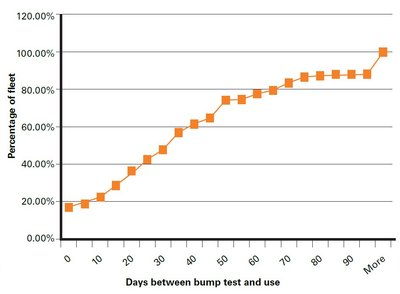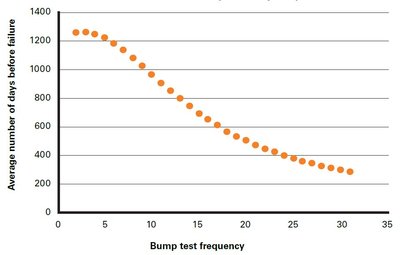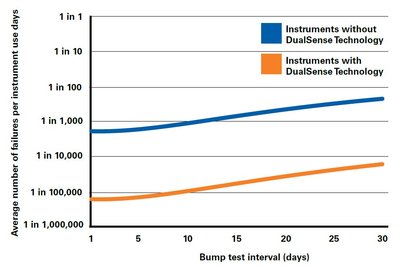Personal gas detectors: why two sensors are safer than one
By Raghu Arunachalam, PhD, Global Director of Multi-Gas Solutions, Industrial Scientific Corporation
Thursday, 07 November, 2013
Manufacturers of personal gas monitors typically recommend that gas monitors be bump tested prior to each day’s use and calibrated at least monthly. But how necessary is daily testing and how does it affect safety?
In environments where there is a risk of harmful gas exposure, it is essential to use personal gas monitors to keep people safe, and so the regular maintenance of gas monitors is necessary if they are to perform their lifesaving function.
The industry standard practice for maintaining gas monitors is to perform periodic calibration and to perform regular functional tests (otherwise known as ‘bump’ tests). The role of calibration is to ensure the continual accuracy of the gas monitor, but a bump test verifies that the monitor is in fact working properly by checking that the sensors are responding to gas and the monitor is alarming appropriately.
In practice, most use cases of gas monitors are more concerned with detection and alarming as opposed to reading the exact concentration of gas, since the primary purpose of many gas monitors is as personal protection equipment (PPE). Calibration and bump tests are both performed by exposing the monitor to a measured concentration of gas and verifying the response, and may be done manually or through automated test equipment such as docking stations. Manufacturers typically recommend that gas monitors be bump tested prior to each day’s use and calibrated at least monthly.
But how realistic are the manufacturers’ recommendations? And do the users of the gas monitors actually comply with these recommendations? After all, if users don’t comply then the recommendations only serve in covering the manufacturer from potential liability. It does nothing to keep the end user of the gas monitor any safer. So the question then becomes whether the testing interval impacts safety in a real way.
Real bump test practices
To find out how gas monitors are being tested, Industrial Scientific Corporation studied more than 25,000 gas monitors used in the field over a period of two years. It found that about 20% of users bump tested their monitors prior to each day’s use, while 15% never bump tested. The rest of the users’ practices fell somewhere in between, with the average user bump testing once a month (see Figure 1).
This raises the question: why is the level of compliance with manufacturers’ bump test recommendations so low? There are a number of contributing factors:
- Education/training.
- Practicality of performing a bump test before each day’s use.
- Costs in time and money.

As is the case with most safety practices, education and training is essential and must be ongoing. Nevertheless, it was found that despite education and training, the practicality and cost of bump testing were even more significant barriers to complying with a manufacturer’s bump test recommendations. In many applications, users work remotely in environments that prevent them from being able to bump test their instruments and make it difficult for their supervisors to monitor that these tests are in fact being performed as prescribed. In other applications, particularly where large gas monitor fleets are involved, it is a logistical challenge to ensure that all monitors are bump tested at the start of each day. While calibration docking stations have helped to automate and simplify this process, it comes at a cost. This is particularly true in the case of single gas monitors where fleets are large and docking stations add significantly to the cost of ownership.
What are the risks of not bump testing?
It seems to make sense that more regular bump testing would be safer because there is higher likelihood of discovering faulty detectors. But is there a big difference between bump testing every day versus every week? What about every month?
The results of more than 2 million bump tests conducted in the field were studied. This study involved sensors manufactured by a number of manufacturers and focused on widely used electrochemical and catalytic sensors. The risk was measured by determining the average instrument use days before a failure for a given bump test schedule (see Figure 2).

It was found that users that bump test their instruments every day experience an average of one failure per 1253 instrument use days (about 3.5 years). Users that bump test once a month experience on an average of one failure per 286 instrument use days. This means that a vast number of users today are over four times less safe than they can be if they bump tested prior to each day’s use.
It is important to point out that bump testing every month will not necessarily result in an injury or fatality every 286 days - the user would need to be exposed to harmful levels of gas, as well. Nevertheless, it is apparent that the monthly bump test schedule adds to the risk factor.
So frequent bump tests are important, but only about 20% of users (at best) bump test prior to each day’s use. Further, a vast majority of these users are aware that they should be bump testing every day but they simply cannot due to operational and cost challenges.
Dual sensor technology
Sensor failures are by far the greatest cause of gas detector failures. All major manufacturers of gas monitor sensors use similar technologies - the vast majority of these being electrochemical sensors (used to detect H2S, CO, O2, etc) or catalytic bead sensors for explosive gas detection. These sensors have been around for a number of years and, as such, are well understood. Their primary appeal is that they are simple, cheap and reasonably reliable as long as regular bump tests are performed. While newer sensors with cutting-edge technology seem perpetually on the horizon promising significant benefits, the ready availability and cost-effectiveness of traditional electrochemical and catalytic sensors make them the mainstay of the industry.
By adding sensor redundancy, the safety and maintenance challenges of current gas monitors can be overcome. The two different sensors sense the same gas and provide simultaneous readings to the monitor electronics that applies a proprietary algorithm to calculate and display a single reading. The dual sensor technology, in conjunction with a daily self-check that verifies proper operation of the monitor electronics and alarms, makes for a vastly safer and more cost-effective monitor.
How much safer is a user of a single gas monitor with dual sense technology than a user of a traditional single gas monitor with a single sensor? Let us take the case of a traditional single gas monitor and compare it to an instrument with ISC’s DualSense Technology. Using the data presented in the previous section on failure rates, the failure rate for DualSense-based monitors can be calculated. Figure 3 compares the safety of the two types of monitors in terms of average instrument use days before failure. In the case of both monitors - those with DualSense Technology and those with a single sensor - in which they are bump tested before each day’s use, we can expect one failure in over 300 years for the instrument with DualSense Technology as opposed to one failure in 3.5 years with the traditional instrument. If the aforementioned monitors were bump tested every month then, on an average, the failure rate of the instrument with DualSense Technology is one failure in just under six years compared to one failure in 286 days for traditional gas monitors.
It is apparent from Figure 3 that the monitor with dual sensors is much safer than a traditional single gas monitor irrespective of bump test schedule. On average, the instrument with DualSense Technology is 85 times safer. Even in the extreme comparison of a traditional monitor that is bump tested every day versus a dual sensor monitor that is bump tested every month, the latter is 17 times safer than a traditional monitor. It is clear then that incorporating dual sensor technology is a cost-effective means to significantly improve safety of a gas monitor in real-world conditions - conditions where it might or might not be possible to perform a bump test before each day’s use.

The ready availability of working gas monitors is a critical part of keeping production lines and drilling rigs, for example, working. Without working monitors, productivity might go down, costs might increase with the need for back-up instruments within the fleet or, at worst, a user goes into the field to do work with no instrument at all. A redundant sensor provides a short-term solution when one sensor fails for people to still be able to go out and do their jobs, though overall safety must be maintained by performing more frequent bump tests. This is analogous to a spare tyre in a car. It is a valuable back-up and means the car is available to drive though it must be driven with some constraints - driven at a slower speed and for a short distance.
Summary
It is clear that bump tests are critical in establishing that instrument sensors react appropriately to gas and that the instrument alarms before it is relied on to keep its bearer safe; but at best, about 20% of users of gas monitors perform bump tests prior to each day’s use. About 15% (probably more) never perform a bump test at all.
Users who bump test every day can expect, on average, one failure per instrument every 3.5 years, but given the low frequency of bump tests performed in the field, the reality is that a number of gas monitor users are putting their lives at risk every day.
Irrespective of bump test frequency, an instrument with dual sensors is safer than a traditional monitor (85 times safer on average).
What is new with the European machinery directives?
The EU Machinery Directives are currently being superseded in favour of the Machinery Regulation,...
Integrating standard signals into functional safety
Non‑binary signals such as analog inputs and encoder readings are very common and should be...
Light curtain or safety laser scanner?
Safety light curtains and safety laser scanners are the two most common machine protection...











